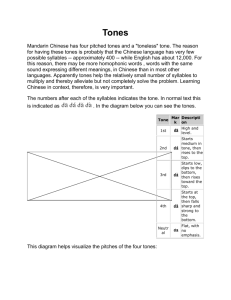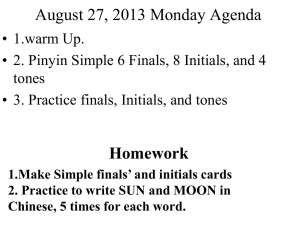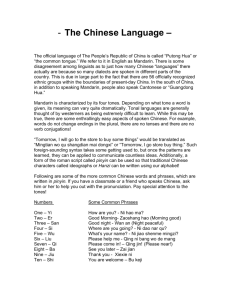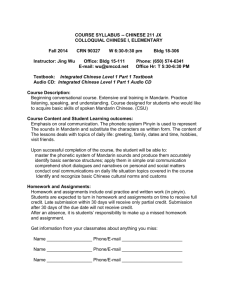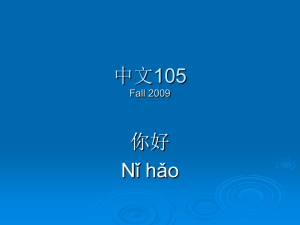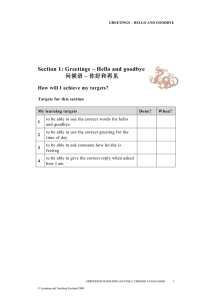The consists of Mandarin Chinese
advertisement
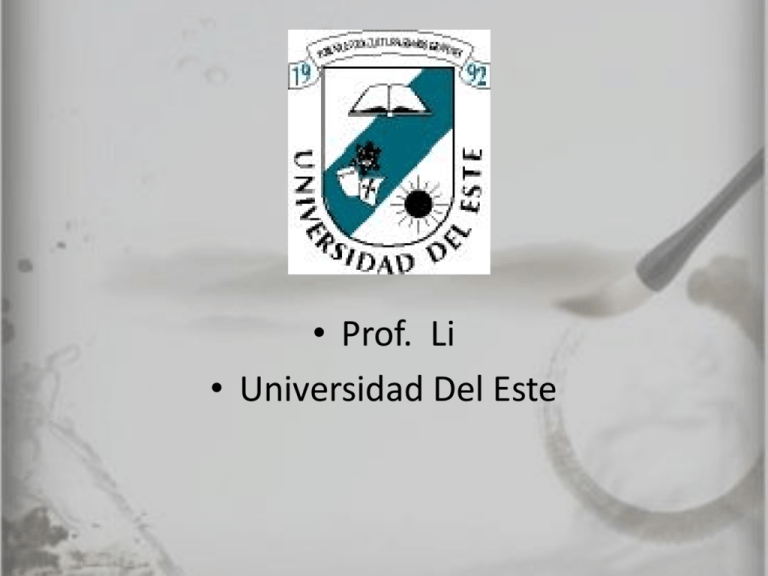
• Prof. Li • Universidad Del Este Review of Greetings GREETINGS nǐ hǎo 你 好 nín hǎo 您 好 xiè xiè 谢 谢 bú kè qi 不客气 duì bù qǐ 对不起 méi guān xi 没 关 系 Zài jiàn 再 见 ACTFL http://www.actfl.org/publications/gu idelines-and-manuals/actflproficiency-guidelines-2012/english European Council http://en.wikipedia.org/wiki/Commo n_European_Framework_of_Referen ce_for_Languages Power Speak http://www.suagm.edu/une/ Reflection of KWL Color in China RED White Yellow Green One-child policy toilet You’ll be able to • • • • Learn more basic expressions Learn pinyin in a general way Learn initials and finals in a general way Learn 4 tones of Mandarin Chinese Basic Expressions 2 zǎo shàng hǎo 早 上 好 días buenos morning good Good morning xià wǔ hǎo 下 午 好 tardes buenos afternoon good Good afternoon wǎn shàng hǎo 晚 上 好 evening good noches buenos Good evening Practice Introduction of Pinyin The consists of Mandarin Chinese Pinyin Chinese character Pictures of pinyin and Chinese characters nǐ hǎo 你 好 xiè xiè 谢 谢 duì bù qǐ 对不起 nín hǎo 您 好 bú kè qi 不客气 méi guān xi 没 关 系 • Putonghua is the common language of the Han ethnic group in China. It's standard Chinese language. It's Mandarin and official. It's based on Beijing phonetics and the dialect of the northern China. • There are two system in written Chinese. One is simplified, the other is traditional. The simplified is used in Mainland. The traditional is used by Hong Kong, Macao, Taiwan and overseas Chinese communities. Pinyin Chinese Phonetic System One syllable=initial +final+tone • initials • There are 23 initials in Mandarin Chinese • finals • There are 24 finals in Mandarin Chinese Introduction of initial initial • The initial refers to a consonant which appears in the initial position of a syllable Song of Pīnyīn Initials • https://www.youtube.com/watch?v=jj3plQP1 60E&list=PLB6266DC316090F76 (1.2 min) Introduction of final finals • appear in the final position of a syllable Song of Pīnyīn finals • https://www.youtube.com/watch?v=3sS5f5u6 QGA ((29 sec)) Introduction of Tones TONES 1. Definition • Chinese is tone language. By tone language I mean the language in which every word has its specific tone or tones. 2. Importance • Tones can distinguish meanings. Different tones have different meanings. For example, the four pinyin have the same initial and final. They are different only in tones. Tones 1st tone 2nd tone 3rd tone 4th tone In a syllable, the tone falls on the vowels: a, o, e, I, u, Ü; e.g. ā á ă à • Where to place tone marks? • Generally, put it on the major vowel of the "final". Then what's the major vowels? It's that one that appears ahead according to the order "a o e i u ü". e.g. in “hao”, “a” comes before “o”, so we have “hǎo” • Some words have unstressed syllables which one toneless and therefore they are not given tone marks. Eg. Xiè xie • https://www.youtube.com/watch?v=p5BTf0MB7k • Tones start from 2:00

